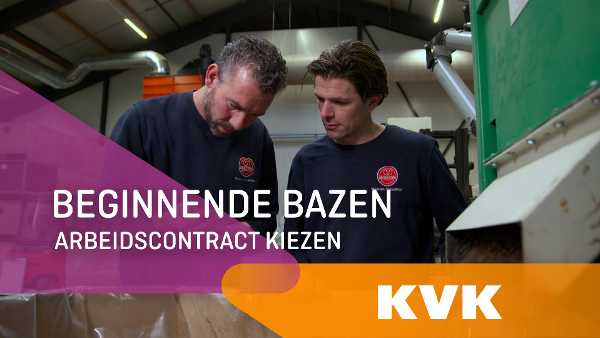Prevent claims for damages: use the correct collective labour agreement (CAO)

- Amber Kuipers
- How to
- 2 March 2023
- 6 min
- Managing and growing
- Staff
A claim for millions of euros in damages for not using a collective labour agreement (CAO)? It happens. Both employees and labour unions can demand financial compensation after the fact if you ignore employment conditions from a CAO, such as a pension scheme, minimum wage or a weekend bonus. So, you should always check if the employment contract you sign with an employee is subject to a CAO, and which is the right one.
A collective agreement includes agreements about topics such as the minimum wage, pension schemes, overtime and allowances, but also breaks or workplace design. If a collective labour agreement applies to your branch or industry, you must always use it. Which CAO applies to your situation may not always be clear. So, sometimes employers choose not to use a CAO, or they use the wrong agreement.
Checklist: ‘Which CAO applies to my business?’
How you check whether a collective agreement applies to your employment contract, and which one it is, varies per situation. Read below to learn what you can do in different situations to find out if a CAO applies to your business, and if so, which one.
CAO with other employers
You have a CAO with a labour union together with other employers. This is referred to as a sectoral CAO (bedrijfstak-cao). You must always use the employment conditions in this CAO.
CAO for the whole company
If you have drawn up a CAO for the whole company, it is called a company CAO. Large companies often do that to save time on negotiations. If you want to draw up a company CAO, you should first check if there is already a sectoral CAO for your branch or industry. Is there a sectoral CAO, but you do not use it? Then the labour union or employee can demand employment conditions after the fact, such as a pension scheme that is included in the sectoral agreement, but not in your company agreement.
CAO for the whole branch or industry
Have you not drawn up a company CAO, and is your company not a member of an industry association? Then check the CAO overview by the Ministry of Social Affairs (in Dutch)to see if a CAO applies to your branch or industry. Please note: when you search for a CAO in this list, you will see several results. This is because the search results also show collective agreements from previous years. Some entrepreneurs choose the wrong CAO from this list. So, always check the date when looking for the right CAO. You can find the date at the end of the file name. Once you have found the right CAO check if it has been declared generally binding. That means it applies to all employers in the branch or industry. This is not always mentioned in the CAO itself because a CAO can be declared generally binding at a later date. You can find out if a CAO is generally binding on the website of the labour union that made the agreement. One example is the CAO for the hospitality industry (in Dutch).
Member of an employer’s association
Are you a member of an employer’s association? Then check if your association has a CAO with a labour union. If so, then the agreement also applies to you.
CAO expert Jan Engelvaart recommends that you regularly check if a CAO in your sector has been declared generally binding. “Often, CAOs are declared generally binding after they are written. It is possible that the CAO was not generally binding at the moment you signed an employment contract with an employee. If the CAO is declared generally binding later, then you have to apply the conditions from that CAO. Even for employees who already had an employment contract.”
Be careful with the SBI code
Please note: entrepreneurs who use their SBI code (code that describes the company’s activities) to find the right CAO can sometimes have problems. Your business activities may be different from the activities covered by the SBI code.
For example: you have a copy shop that also sells paper and makes prints. You are registered in the Business Register with the SBI code for ‘trade in paper and cardboard’. The collective agreement for non-food retail (in Dutch) that applies to the SBI code does not apply to all of your employees: someone who does print work falls under the collective agreement for graphic media (in Dutch).
Pitfalls when choosing a CAO
Sometimes employers choose not to use a collective agreement, or they use the wrong agreement, because they are not sure which one to use. That regularly happens in the following situations:
Doubts about the right collective agreement
You think you found a CAO in the overview by the Ministry of Social Affairs (in Dutch), but your business activities do not entirely match the activities covered by that CAO. The description of the business activities in the CAO are often referred to as the ‘scope of work activities’ (werkingssfeer bepaling). Which business activities fall under which CAO may seem simple, but in practice it can often present some surprises. Sometimes the business activities match the employee’s job description, as in the collective agreement for hairdressers(in Dutch). Sometimes the business activities depend on the end product that the company makes.
For example: you are a furniture maker, and you build furniture using machines. In this case, you have different working conditions than a furniture maker who builds furniture by hand. The end product is the same, but it is made using different methods. And then the business activities may be different too. So, your employees fall under different CAOs.
If you are not sure about the CAO or scope of work activities, you should contact your industry association or ask a legal expert for advice. Also remember to check if the CAO has been declared generally binding. Because then it applies to all employees in your branch or industry.
Doubts about the working conditions provision
If you have doubts about the description of your business activities in the CAO, you can ask someone to conduct a working conditions survey (in Dutch). Keep in mind that the wrong description of the working conditions can have major financial consequences.
For example: the CAO for cleaners and window washers says that every business that ‘has the main or secondary profession out of regularly or occasionally cleaning and/or washing windows at a location chosen by the client in or on buildings, homes, streets/roads, (household waste) containers, lots and/or traffic facilities, in the broadest sense of the word’ falls under the CAO.
Your shop employs sales staff whose job includes washing the window twice per year. You use the CAO for retail, and not the CAO for cleaners and window washers. In this case, your sales staff can claim that they have the right to certain employment conditions due to the cleaning work they do. As a result, you must pay financial compensation.;
Your product or service is part of a finished product
Sometimes the work activities determine which CAO applies, and not the finished product (the product that the customer buys). If you supply part of that finished product, your company may not fall under the CAO for that finished product.
For example: you sell recreational yachts. You furnish the metal hull of the yacht with wood that you buy from another company. Since you sell metal yachts, you use the CAO for metal and electric work, but the right CAO is actually the agreement for the wood processing industry.
One business, different work activities
Sometimes a company may have several different business activities. In that case, different CAOs apply to different employees. One example (in Dutch) is a supermarket with an in-house meat department. Employees in the meat department fall under the CAO for meat processing, not for retail staff. Make sure to check which CAO applies to each employee.
Your business activities change
If your business activities change, then you should check if the CAO changes as well. Or maybe you a CAO did not apply before, but does now. Or maybe you need to use a different CAO for new employees. You are responsible for using the right CAO. Engelvaart recommends that you ask a legal expert or another entrepreneur in your field if you are not sure. A legal expert will know if you still fall under the same scope of work activities and another entrepreneur in your field will know what work is involved in new business activities.
You employ on-call staff
The CAO for temporary employees (in Dutch) applies to temporary employees of an external agency. The temporary employment agency will use the collective agreement for the employment contract.
Expiration of a generally binding collective agreement
When a CAO expires, for example after 2 years, then it is no longer generally binding. You do not have to use the employment conditions from the CAO until a new CAO has been declared generally binding. This means that for example, under the old CAO you had to pay weekend allowances, and now you do not. "This CAO-free period' can sometimes last up to nine months due to CAO negotiations," Engelvaart explains. "During that period, you as an employer determine the terms of employment yourself."
Keeping an eye on CAO developments
If you have concluded a CAO, it is wise to keep an eye on its developments. The CAO viewer (in Dutch) informs about the most recent CAO agreements.


